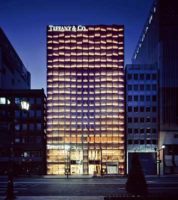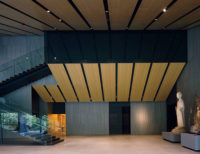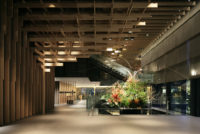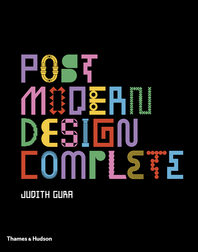Kayanoya by Kengo Kuma and Associates
Tokyo












Architects & Firms
The clean scent of freshly cut cedar creates a strong first impression at Kayanoya, the eponymous retail offshoot of a traditional soy sauce manufacturer, designed by Kengo Kuma. A true delight for the senses, this specialty food shop in the middle of Tokyo's Nihonbashi district engages not just smell but also sight, touch, and taste with a bold interior that evokes the 120-year-old company's Kyushu countryside headquarters.
Additional Content:
Jump to credits & specifications
Once the bustling commercial center of Edo (as Tokyo was called until the Meiji Restoration in 1868), Nihonbashi was eclipsed by other business and shopping hubs as the city grew. To help revitalize the area, developer Mitsui Fudosan created a mixed-commercial-use building complex—named Coredo or “the core of Edo”—where a themed retail mall on the lower floors features stores selling traditional Japanese goods with a contemporary twist. Kayanoya, a purveyor of soy sauce, soup stock, and other packaged foods, occupies a prominent ground-floor spot on Chuo Street, the area's main artery.
Accessible from both street and mall, the L-shaped shop has a small, adjacent wrapping and storage area concealed behind Japanese-style noren curtains. Kuma arranged distinct places for display, meeting, tasting, and paying within the selling floor, defining each by built-in casework or furnishings made with cedar kojibuta trays and decorative barrels inspired by those used in traditional soy sauce–making.
The massive casks normally sit on the ground, brimming with briny liquid. At Kayanoya, Kuma used them in lieu of a conventional dropped ceiling. This enabled him to mitigate the shop's 18-foot structure-to-structure height while maintaining a shadowy quality beneath the overhead slab.
“When I visited Kayanoya's factory, I loved the darkness under its pitched roof,” explains the architect. “I wanted to achieve that effect within a commercial building.” Laced with exposed ducts and other mechanical equipment, the slab's underbelly bears little resemblance to a traditional Japanese manufacturing facility, yet the hovering wooden drums and their incongruous backdrop add drama to an otherwise cookie-cutter space.
Fabricated by a Kyushu carpenter, the 14 barrels range in diameter from 6 to 11 feet. Each one is made of cedar staves secured with braided bamboo ties, and conceals a steel frame that attaches to the building's structural system. LED downlights embedded in the barrels' flat bottoms illuminate the merchandise.
By contrast, the kojibuta trays are simple lidless boxes that store fermenting soybeans at the factory—and merchandise here. Made by an artisan with Kyushu cedar, each box measures a customary 1 by 2 feet. Kuma assembled the trays in alternating stacks to yield a flexible millwork system, used for freestanding displays and wall-mounted shelving as well as table and counter bases. “Actually, this is not our design,” says project architect Shuhei Kamiya. “Traditionally, kojibuta were stacked like this so air could pass through.” In Kuma's hands, the functional solid-and-void striping becomes a strong visual motif. “The porosity of the shelves diminishes their overall mass,” explains Kamiya.
Kuma continues to articulate the space through highly textured surfaces. Recalling the factory's rammed-earth floor, the shop's floor slab is covered with a durable surface made from stones, soil, and concrete. Equally evocative of the country's tradition of craft are the washi-papered walls. Made in Fukui Prefecture, the sheets were dotted with drops of water during production to create a spotted motif in high relief. This pattern is prominent on the sidewall and a structural column at the room's center where the paper is on sheets of glass illuminated from behind by LEDs.
Backlit Japanese paper aside, Kayanoya is more rough-hewn than usual for Kuma. Instead of enlisting refined materials, the architect underscores the inherent beauty of the manufacturing process by employing what seems to be merely typically Japanese function-driven design. “I am not nostalgic at all,” he explains. “If we study tradition, we can find that functionalism.”
CreditsClient: Kubara-Honke
Architect: Kengo Kuma & Associates
Architect of record: Kengo Kuma, Kenji Miyahara, Shuhei Kamiya
Consultant(s): Lighting: Daisuke Morita (ModuleX)
General contractor: Nomura Kogei
Photographer(s): Sadao Hotta
Size: 1,450 square feet
Project cost: withheld
Completion date: March 2014 |
SpecificationsInterior finishes Cabinetwork and custom woodwork: Japanese Local Cedar
Wall and column surfacing Washi (Japanese Paper)
Special interior finishes unique to this project DOMA (Dirt Floor with sand and stone) Tables: Japanese Local Cedar
Lighting Interior ambient lighting: Wall illumination with Washi and Glass Downlights: LED universal Downlight Task lighting: LED Spot |












